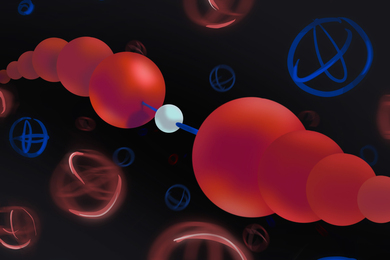Only the sun, which pours more energy onto the Earth's surface in an hour than the entire planet uses in a year, has the capacity to meet future global energy needs -- but people will have to act fast to make use of it, according to MIT Professor Daniel G. Nocera.
The basic science that will help produce an alternative, clean energy source with the help of sunlight needs to be realized within the next 10 years to make a difference, said Nocera, who is the W.M. Keck Professor of Energy and professor of chemistry at MIT.
Nocera spoke Thursday, May 11, on "Powering the Planet: The Challenge for Chemistry in the 21st Century" as part of the MIT Energy Club Lecture Series.
Nocera's laboratory is seeking a future alternative fuel source by studying the principles that govern the conversion of photon energy into chemical potential during photosynthesis. The trick is to design a system in which the energy needed to break the chemical bonds between the hydrogen and oxygen in water is compensated by the absorption of a photon. The payoff: an alternative, clean fuel source -- hydrogen -- produced with the help of sunlight.
"Solar plus water has the capacity to meet future energy needs, but it is the furthest one away" from being realized, he said. "The basic science has to be solved in the next 10 years so that policy and infrastructure can then be addressed."
Nocera targeted 2050 as the year that solar energy will provide a significant portion of the world's energy needs.
He said that basic science has to provide the answers because an engineering approach alone has not worked. "Inroads are possible when renewable energy is tackled as a basic science project. Even photovoltaics has to be viewed as a basic science problem," he said.
In 2004, according to a world energy assessment report done by Caltech, global energy needs were 13.5 terawatts (TW, or trillion watts). Most came from oil, gas and coal. Nocera calculates that world energy consumption will be 28 TW in 2050, maybe closer to 35.
The growing energy needs of China, India and Africa will account for much of that increase, Nocera said. Currently, the half of the world population living in these developing nations uses the least amount of energy. "If you want to be rich, you use energy," Nocera said. "The rest of the world is trying to reach" the high energy consumption level of the U.S. "We have to hope that India and China won't make the same mistakes as us along the way."
Although dwindling supplies of oil and considerable supplies of methane and coal still exist, environmental concerns, rising prices and security issues have finally converged, creating "consensus that we need new energy sources because of these three factors," Nocera said.
Nocera is certain that using solar energy to harvest hydrogen from water will work, although splitting water into its components is extremely difficult because stable bonds hold the molecules firmly together. Nocera's laboratory is working on a system that produces hydrogen, and it has "a foot in the door" on the even more difficult problem of getting oxygen out.
A version of this article appeared in MIT Tech Talk on May 17, 2006 (download PDF).





